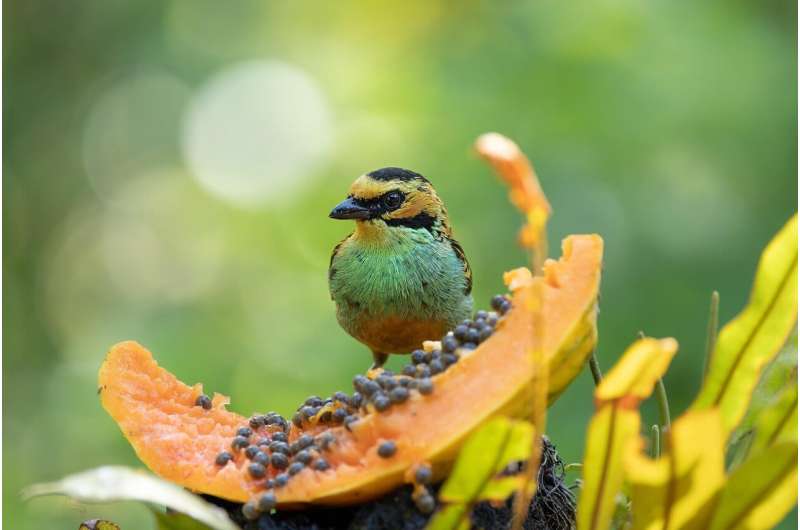Science
Researchers Uncover How Black and White Feathers Boost Bird Colors

Birds are renowned for their vibrant colors, but a recent study from Princeton University has revealed that some species enhance their plumage using hidden black and white feathers. Published on July 26, 2025, in the journal Science Advances, the research led by Rosalyn Price-Waldman demonstrates how these seemingly dull feathers can amplify the brightness of colorful plumage.
The research team found that when colored feathers overlay either black or white underlying feathers, the colors appear more vivid. The study highlights an intriguing aspect of sexual selection, where male birds typically display brighter colors than females to attract mates. This phenomenon, first noted by Charles Darwin, suggests that the most colorful males are more likely to reproduce successfully.
Black feathers contribute significantly to this effect. When bright blue feathers rest atop a black under-layer, the black absorbs excess light that passes through. Consequently, the blue feathers reflect light in a way that enhances their vibrancy. Without this dark layer, the light from other parts of the spectrum could diminish the intensity of the blue, making it less striking.
In contrast, the researchers discovered that yellow feathers benefit from a white under-layer. Yellow pigments, known as carotenoids, are enhanced by the reflection of light from the white feathers beneath. This results in a brighter appearance, making yellow plumage stand out against other colors.
The study primarily focused on various species of tanager, colorful fruit-eating birds found in Central and South America. After identifying the enhancement technique in tanagers, the researchers expanded their study to include other bird families. They found that the use of black and white underlying feathers to enhance color is prevalent in many species, including the Australian fairy wrens, known for their brilliant blue hues.
This discovery suggests that birds have employed this clever method of color enhancement for millions of years. Understanding how these complex traits evolve in nature is essential for broader biological insights. Additionally, the findings could inspire advancements in vibrant color production in architecture, art, and fashion.
The implications of this study extend beyond ornithology, as it enhances our understanding of evolutionary biology and the intricate strategies animals use to thrive in their environments. The research team hopes their findings will spark further exploration into the evolutionary significance of plumage coloration in other species.
-

 Health3 months ago
Health3 months agoNeurologist Warns Excessive Use of Supplements Can Harm Brain
-

 Health3 months ago
Health3 months agoFiona Phillips’ Husband Shares Heartfelt Update on Her Alzheimer’s Journey
-

 Science2 months ago
Science2 months agoBrian Cox Addresses Claims of Alien Probe in 3I/ATLAS Discovery
-

 Science2 months ago
Science2 months agoNASA Investigates Unusual Comet 3I/ATLAS; New Findings Emerge
-

 Science1 month ago
Science1 month agoScientists Examine 3I/ATLAS: Alien Artifact or Cosmic Oddity?
-

 Entertainment5 months ago
Entertainment5 months agoKerry Katona Discusses Future Baby Plans and Brian McFadden’s Wedding
-

 Science1 month ago
Science1 month agoNASA Investigates Speedy Object 3I/ATLAS, Sparking Speculation
-

 Entertainment4 months ago
Entertainment4 months agoEmmerdale Faces Tension as Dylan and April’s Lives Hang in the Balance
-

 World3 months ago
World3 months agoCole Palmer’s Cryptic Message to Kobbie Mainoo Following Loan Talks
-

 Science1 month ago
Science1 month agoNASA Scientists Explore Origins of 3I/ATLAS, a Fast-Moving Visitor
-

 Entertainment2 months ago
Entertainment2 months agoLewis Cope Addresses Accusations of Dance Training Advantage
-

 Entertainment3 months ago
Entertainment3 months agoMajor Cast Changes at Coronation Street: Exits and Returns in 2025









